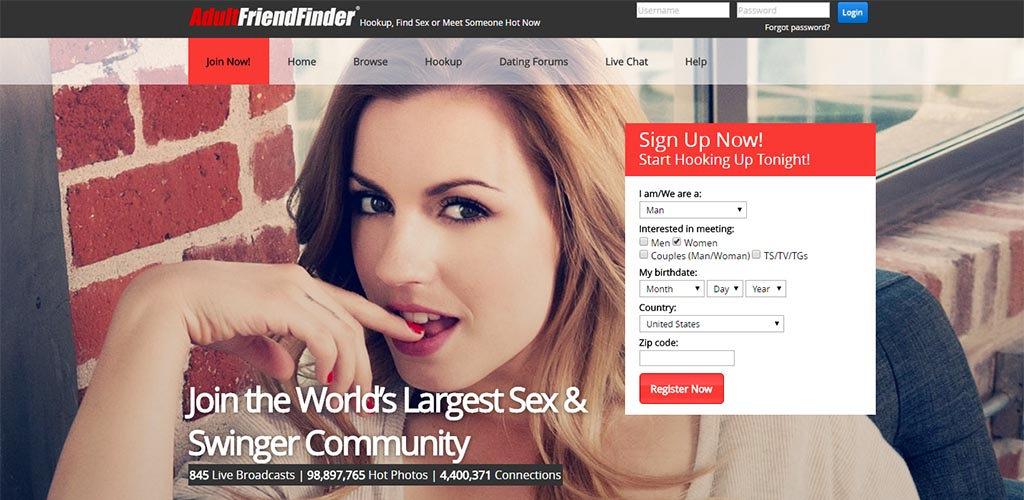Finding casual hookups near where you live can be pretty challenging without a head start. Even if you don't live in a huge city there can be a lot of options to try. Unless you want to spend a lot of time and money doing all the work yourself you need to pay attention to our proven suggestions below that can make finding a hookup tonight a LOT easier.
Let's talk about the elephant in the room: dating apps must be the best way to find casual hookups, right? In my experience, yes and no. The truth is that dating apps can help, but only if they're the ones that work. After testing out hundreds of hookup apps and sites, I can definitively say that these are the ones that can work for a lot of guys:
| Site | Our Experience | Our Rating | Free Trial Link |
|---|---|---|---|
Best Hookup Site For MILFs  | Experience Highlights
| 9 | Try AFF For Free |
Best For Relationships  | Experience Highlights
| 9 | Try eHarmony |
2nd Best For Hookups  | Experience Highlights
| 8 | Try Passion |
Things have been even more difficult lately with so many people out of practice when it comes to socializing in public. You really need to be smart and creative in how you approach finding hookups right now - especially in the wake of people still coming to terms with a post-COVID world. According to a survey by UCLA Health, 88% of respondents said COVID-19 altered their thoughts about dating. In other words, things have become much more difficult to find a casual sex partner.
Thankfully, this guide provides PROVEN suggestions that have worked for us and that we have seen others use to find casual hookups over and over again. Even if you're a guy who isn't great with women these are the places where you can drastically increase the odds that you'll find success. Picking two or three of the options below to check out is going to give you the best results.
If you're looking to find casual hookups near where you live this is where you should start:
Methodology: Our Review Process For This Finding Casual Hookups
At BeyondAges, we take the reviewing process very seriously to ensure our readers receive only the most honest, relevant, and up-to-date reviews for dating success. Here’s a breakdown of how our contributors evaluate the recommendations in this guide:
- Thorough Review Process: All BeyondAges contributors have a rigorous review process to recommend only the best dating apps. They test both the free and paid versions of every app using the same name, photos, bios, and opening lines when messaging people to avoid bias.
- Intense Testing: Every app and dating strategy goes through a thorough testing process to deliver a reliable verdict on its utility. All aspects of every dating app are tested, and a verdict on both the free and paid versions is delivered to the readers. For strategies, such as attending classes or frequenting establishments geared towards socializing, every writer has direct, verifiable experience to provide a more holistic picture of the modern dating paradigm.
- Expert Credentials: Every writer on BeyondAges has decades of experience in modern dating. From dating coaches, psychologists, and those who’ve had success in their romantic life, each writer contributes content that meets BeyondAges’ stringent qualification guidelines.
For more info on our commitment to bring our readers the most accurate content and recommendations, visit our “About” page on BeyondAges.com.
Affiliate Disclaimer:
The content on BeyondAges.com may contain affiliate links. This means that if you click on these links and make a purchase, we may receive a small commission at no extra cost to you. This helps support the work we do and allows us to continue providing valuable insights and recommendations to our readers. Our reviews and recommendations are independent and unbiased, with the aim to provide genuine help and guidance to our audience.
We only recommend products or services that we have thoroughly reviewed and believe provide value. Our affiliations do not, in any way, influence the recommendations we make. We take the trust our readers place in us very seriously.
Please note that the commissions we earn do not impact our views and opinions on the products or services we review. Our aim is always to provide accurate and helpful information to our readers.
Where You Can Find Hookups Tonight Near You
These are our favorite spots. Don't forget to leave a comment below if there are any we missed that work great for you!
AFF - We haven't found an app that delivers better results and you can try it free here
 Guys that aren't great with women, don't have a lot of experience, or just don't have a lot of time to spend meeting women need to try out AFF's trial. From what we've seen, there isn't an option out there that makes meeting a lot of locals looking specifically for hookups any faster or easier. We would know, we have tried out all the legit hookup sites and apps out there in our annual review.
Guys that aren't great with women, don't have a lot of experience, or just don't have a lot of time to spend meeting women need to try out AFF's trial. From what we've seen, there isn't an option out there that makes meeting a lot of locals looking specifically for hookups any faster or easier. We would know, we have tried out all the legit hookup sites and apps out there in our annual review.
We've talked about why we like AFF so much plenty of times in the past but it boils down to a couple of things:
- They have the most users out there looking for hookups locally (over 60 million active users)
- They have delivered the best results when it comes to finding a casual hookup
- Guys who aren't super handsome can still get great results (unlike the other options out there)
When you have an app or site like AFF that delivers both a huge quantity of singles looking for hookups and a great platform for connecting them you're going to get some solid results if you spend a little time perfecting your approach. Don't expect to just put up a blank profile and have women streaming toward you though, nothing is that good!
If you're still in the stage where you need a little help finding hookups near you or you just don't have the time to go out a lot check out AFF's free trial. You don't have anything to lose and could be doing yourself a HUGE favor! It's our favorite.
Testimonials for AFF
“Yes, people really hook up on Adult Friend Finder.
From casual one night stands, to orgies, kinky parties or long-term sex relationships (I prefer the latter) and more.
That doesn’t mean that you need to use common sense and avoid profiles with intent other than just having no strings attached fun.
Those profiles are easy to spot though with a bit of experience.
First, sign up to a free account, “see this link”.
Fill your profile, etc. and make sure that your location has enough potential profiles, women or men to make it worth it.
Then, I cannot emphasize enough how you need to be honest for this thing to work. People are there with all kinds of backgrounds, failed marriages, unsatisfied sex, never had an orgasm, etc. so at best it’s a place where you can communicate all these things openly without feeling ashamed.
The most amazing women I’ve met are when we were able to share our stories in all honesty, which resulted in getting us really close and to find a meaningful, commitment free relationship for having amazing sex whenever both of us felt like it.
That’s what Adult FriendFinder is or at least has been for me and should be for others too in my opinion. Anything else is just a waste of time, and sure, you can easily waste your time there just like anywhere else if you don’t know what you are doing.
When it comes to hooking up, there is so much scam stuff going on and people who are mostly interested in money. It’s impossible to filter all that, but at least on AdultFriendFinder you have the real thing and they manage to get less of it than elsewhere.
Compare a place like Reddit which has been completely raided by escort women. So if you meet a profile with big tits and willing to send you her naked pictures, it’s because that is something too good to be true/not real.
When you chat with someone, if they are genuine, you know it. And if you are your genuine self, this will support the other person to do the same and find out if you are compatible in bed and otherwise or not.”
Bars (obviously)
 The first thing most people think of when it comes to finding casual hookups is bars. We wanted to cover it first just to get the obvious choice out of the way. Typically, bars are great options for two reasons:
The first thing most people think of when it comes to finding casual hookups is bars. We wanted to cover it first just to get the obvious choice out of the way. Typically, bars are great options for two reasons:
- Everyone knows that people go to bars to find local hookups
- There's plenty of alcohol around to loosen people up
If you're a pretty outgoing person and don't have any trouble just walking up to people and starting conversations bars are going to be a great option. You'll have plenty of opportunities and should have a great time. If you're a bit more introverted or just don't feel comfortable in bars there are some other great options below you should try instead.
BeyondAges has great guides for picking women up at bars:
How To Talk To Girls At Bars And Get Them Interested In You
Author: Jennifer Greene, Dating and Sex Coach for BeyondAges.com.
Excerpt: Greene offers a great tip to help men play the room and have a more laissez-faire attitude to finding women at bars. She says, “For guys who don’t know how to talk to a woman at a bar, one of the biggest mistakes they make is trying to hang on too tight. If you’re talking to a girl and she and you are having fun, but she excuses herself, don’t beg her to stay. Definitely don’t criticize her for it. Let her go.”
Get some local advice on where to find hookups
We know that where you spend your time is absolutely crucial to finding the success you're looking for. We think it's so important that we have put together over 100 guides that contain specific recommendations for places you can go to improve your chances of finding a successful hookup or if you're just looking to find girls for one night stands.
These are city guides created by people who know what they're talking about. Check out a few of the spots for your city, or a city you're traveling too, and see just how much your success improves!
Where to find casual hookups in the United States
Outside of the major cities try these guides by state
Where to find casual hookups in Canada
Where to find casual hookups in the United Kingdom and Ireland
Where to find casual hookups in Australia
Where South African hookups are happening
Online Forums and Social Meetup Groups
Just because you’re virtual doesn’t mean you can’t be local.
Another great “local” source of finding sex partners is by participating in Online Forums and Social Meetup Groups. These platforms often have communities of people interested in casual hookups near you.
Remember, local scenes and friend groups form all the time - especially for a safe and vetted team of mature adults.
Similarly, you can participate in niche forums that are in your area that have nothing to do with sex (at least overtly). For example, if you’re interested in finding golfing partners, a simple search for “golfing forum + [YOUR CITY]” will point you in the right direction. And for those who are even more savvy (and prefer a younger audience), Discord has just about any topic under the sun in your area.
Also, don’t forget about tried and true platforms like Meetup. If you need to find a new community of people that can be viable sex partners, Meetup makes sense. After all, having fun during singles mixers, hobbyist groups, career events, and more means you’ll be exposed to a wider number of people.
Last on the topic of local groups: If you’re really adventurous and willing to put up with the process, there’s always speed dating events in your area. While you may be put off on the idea of attending this short-term social event (“ugh, it’s come to THIS…”), the truth is that you’re missing out on PLENTY of women who are equally fed up with their friend circle and local prospects.
Andrius Saulis, a Dating Coach and writer for Beyond Ages, explains this well in his recent article, “The 7 Alternatives to Online Dating That Are Most Successful in 2024”:
“Speed dating may sound like a thing of the past, but it’s actually great and is pretty much “real-world Tinder.” Basically, you get to go through a LOT of people very quickly and see if you click or if there’s any chemistry.”
REAL dance clubs (not just places with a DJ)
 There are a lot of places that call themselves dance clubs but are really just a bar with a DJ. Nobody is really dancing, it's more like drunk people swaying to the music. These "clubs" aren't bad spots to find a casual hookup but they aren't the best either.
There are a lot of places that call themselves dance clubs but are really just a bar with a DJ. Nobody is really dancing, it's more like drunk people swaying to the music. These "clubs" aren't bad spots to find a casual hookup but they aren't the best either.
The best dance clubs tend to specialize in a certain style of music. We're talking about Latin dance clubs where they mainly play salsa or tango music styles or even electronic dance clubs. This level of specialization allows you to know what you're getting into and tends to attract people who are much more into the music and the actual dancing (not just drinking and throwing their hands in the air).
Dancing between two people who are having fun and enjoying the music, and each other, is as close to sex as it gets in public. You can feel the connection between two dance partners and it's often a very short trip from the dancefloor to the bedroom.
Finding hookups near where you live is often as easy as finding the closest dance club, the hardest part is finding places you can go to hookup without getting caught if you can't bring a girl home! If you're not a great dancer don't be afraid to take a lesson or two and stop taking yourself so seriously. You can have a lot of fun with the right attitude right from the beginning.
Marwan Jamal, an expert dating coach and writer for Beyond Ages, l has a great recommendation to stand out in a digital-heavy dating environment: reading. Jamal says, “Women want men who are better than them physically, financially, and intellectually. Women crave intellectual stimulation as much as they crave physical intimacy, and a man who reads is a man who can literally talk about anything and still sound interesting.”
Tinder is an easy place to find a hookup tonight if you're super hot already
 The opposite of AFF, which tends to work best for most guys, is Tinder. Tinder is great for guys who fall into the top 10-15% in looks and have a lot of confidence. If that sounds like you then Tinder is going to be a lot of fun. Finding a one night stand online isn't always easy but if you're really good looking Tinder can help.
The opposite of AFF, which tends to work best for most guys, is Tinder. Tinder is great for guys who fall into the top 10-15% in looks and have a lot of confidence. If that sounds like you then Tinder is going to be a lot of fun. Finding a one night stand online isn't always easy but if you're really good looking Tinder can help.
Most of you have probably tried Tinder in the past and most of you probably didn't have a great experience. From what we've seen, it tends to be the most handsome guys getting all the attention from 85%+ of the women using it. That leaves something like the bottom 15% of women for the remaining 80% of guys. NOT a great experience. Tinder also skews more toward people in their late teens and 20's.
We almost didn't include it on our list but we wanted to be fair to everyone. There ARE guys who can do great on Tinder but they tend to not be the ones who need Tinder when they're looking to find a hookup that night.
Testimonials for Tinder
Question: Is Tinder a waste of time for guys?
“Depends. Some men have done well on there while others haven’t. A lot apparently has to do with the area as well. Sometimes it’s just luck.
Tinder is largely known as a hookup app - if you’re going on there looking for a meaningful relationship, you’re more than likely won’t find it.
I live in the NYC area, so I can only go by what my experiences were on the app. Tinder may work better in another area.
I chatted with maybe 2 normal women - the rest were scammers, escorts, men posing as women, & bots. I received a lot of “likes” - but they never amounted to anything. I swiped right on a bunch and hardly ever got a match. Couldn’t tell if they had long abandoned the app or not.
Of course men looking for hookups are the norm online and this app is no different. I can’t even imagine all the real women on there and how many “likes” they have to put up with.
I tried most sites/apps for dating and whatnot. I found Tinder to largely be a waste of time. And I tried it twice in a span of a year. I heard of Tinder over the years, but I’m guessing it’s just a rotted shell of what it once was.
If you’re looking for a relationship, Tinder is a waste of time unless you just want to swipe away on women you’re attracted to out of boredom.
If you’re looking for a hookup/nsa/fwb - then Tinder is just like a lot of other apps out there and only has the name. You could do a lot better and you can do a lot worse. Only decent thing Tinder has over an app like say Badoo, is that you’re less likely to find people living multiple states away or in other countries.
Again, I can only speak from my area. From what I’ve seen on here(Quora), other areas seem to do better for men - so depending on where you’re from and what you want, you may like it. Worth a try if you’re curious, but go in with very low expectations."
Hotel bars are great for finding short-term flings
 If you're in the mood for a hookup tonight but don't want more than just a one-time thing consider hitting up one of your local hotel bars. Do a bit of research first (check out our city guides above) because you are looking for a particular kind of hotel bar. This isn't just some dive bar next to a Motel 6 that you want.
If you're in the mood for a hookup tonight but don't want more than just a one-time thing consider hitting up one of your local hotel bars. Do a bit of research first (check out our city guides above) because you are looking for a particular kind of hotel bar. This isn't just some dive bar next to a Motel 6 that you want.
What you're looking for is a bar that attracts a lot of business travelers, not traveling families. These tend to be a little more upscale with a big bar and wide selection of alcohol. Martini bars, whiskey bars, and other cocktail bars tend to be better options than sports bars. This is where a lot of the visitors who are in town for business, but might be up for a little fun with the right person, tend to hang out.
Hotels bars are great because it isn't just near where you are but it's technically right next door to where who you're hitting on lives too (at least for that night). Moving a fun conversation toward a casual hookup is a lot easier when the bedroom is just down the hall.
Want to be the life of the party and get a new girl? Read these great articles from BeyondAges:
One of the most popular guides on BeyondAges is “How To Get A Girl At A Party Without Being A Natural”, written by Andrius Saulis, a professional dating coach and educator with over a decade of hands-on experience. You’ll learn how to navigate the ins and outs of socializing at parties the right way - here’s an excerpt: “Be social with both guys and girls. Learn who everyone is without any ulterior motive whatsoever, except for meeting and getting to know everyone there. “
Want to learn even more? Check out these articles below:
- How to Get Laid at a Wedding in 2024
- How To Meet Girls In College
- Where To Meet Women: A Guide For The Single Man
- 6 Places to Meet Girls For One Night Stands
Parties (both casual and business)
 Any place where a lot of people are having fun in the evening and the booze is flowing tends to be a good places to find a casual hookup. This is especially true when people are letting loose and in the mood to talk and meet new people. That's why parties can be such great opportunities.
Any place where a lot of people are having fun in the evening and the booze is flowing tends to be a good places to find a casual hookup. This is especially true when people are letting loose and in the mood to talk and meet new people. That's why parties can be such great opportunities.
It doesn't matter if your at a friend's house or a business party take advantage of the opportunity and meet as many people as you can. The odds are you are going to find someone who is also in the mood for a hookup, lives near you, and maybe even relaxed enough to act on it. When you're at a party you always have an easy excuse to introduce yourself and start a conversation by asking them how they know whoever is hosting the party.
If it's a business party you do need to be a little more discreet and cautious. There are plenty of people who like to mix work and pleasure but finding a quick hookup that night is a little more dangerous. You want to make very certain that you're both into each other before making a move. Just don't wait too long!
Work (definitely dangerous but that's half the fun)
 It's hard to find a hookup closer to you than with someone you work with (maybe even AT work). Hookups between coworkers happen ALL THE TIME. It natural to become attracted to someone you see regularly and has qualities you find appealing. The trick is making sure that your casual hookup stays casual and doesn't interfere with your job!
It's hard to find a hookup closer to you than with someone you work with (maybe even AT work). Hookups between coworkers happen ALL THE TIME. It natural to become attracted to someone you see regularly and has qualities you find appealing. The trick is making sure that your casual hookup stays casual and doesn't interfere with your job!
To do this, you need to be very clear with each other what your relationship is and what your expectations are. The last thing you want is someone to think it's more serious than it is. You also want to take great pains to keep things just between the two of you. The fewer people that know about what you're doing the easier both of your lives will be.
Also, be very professional at all times when you're at work together. Don't give any indication to your coworkers about what's going on between you and don't give each other preferential treatment. Most people could care less who is hooking up as long as it doesn't impact their job.
Looking to get comfy with a colleague? BeyondAges shows you the safest and easiest ways out there:
Looking to “discuss” more than work with someone at your job? How to Tell if a Girl Likes You at Work by Andrus Saulis guides you through the major signs that you should look for when trying to take your “work wife” to a real relationship. Here’s an excerpt where Saulis discusses the importance of understanding the signs of a bonafide office romance:
“If you misinterpret certain signs of professional courtesy or friendliness and take them the wrong way, you may get into a lot of trouble with your boss or HR. And in some severe cases, it may even cause you to lose your job and your reputation.”
More articles about work-based relationships from BeyondAges.com:
- 10 Ways Flirting At Work With An Older Woman Works
- How To Tell If A Female Coworker Likes You
- How to Flirt at Work in 2024 Without Risking Your Job
Pros and Cons of 8 Proven Places to Find Casual Hookups
| Place | Pros | Cons |
| AFF |
|
|
| Bars |
|
|
| Local Advice |
|
|
| Real Dance Clubs |
|
|
| Tinder |
|
|
| Hotel Bars |
|
|
| Parties |
|
|
| Work |
|
|
Safety and Precautions: Staying Safe While Having Fun
Casual sex can be an enjoyable and consensual activity, but ensuring safety and taking precautions is of utmost importance. Here are some key recommendations for a safe and satisfying experience from Psychology Today regarding hookups and casual sex:
- Communication is Key: Open, honest, and clear communication is vital. Discuss boundaries, desires, and expectations with your partner to ensure mutual consent and comfort. Effective communication helps establish trust and ensures that everyone's needs are met.
- Protect Against STIs: Consistently using barrier methods like condoms is crucial to reduce the risk of sexually transmitted infections (STIs). Both you and your partner should prioritize safe sex practices.
- Verify Consent: Always ensure enthusiastic, ongoing consent from all parties involved. Consent should be clear, voluntary, and revocable at any moment. It's essential to respect boundaries and be prepared to stop if someone feels uncomfortable.
- Know Your Partner: Take the time to get to know your partner better before engaging in casual sex. Meeting in public places first can help build trust, and sharing personal information responsibly is a smart precaution. Trust your instincts and prioritize your safety.
- Choose Safe Locations: Select safe locations for encounters. Inform a friend about your whereabouts, especially when meeting someone new. Opt for neutral, public spaces for initial meetings to ensure your safety.
- Stay Sober: Avoid excessive alcohol or drug use before and during casual encounters, as it can impair judgment and consent. Being in control of your faculties is essential for making informed decisions.
- Have an Emergency Plan: Always have an emergency plan in case things don't go as expected. Share your location with a trusted person who can assist you if needed. Being prepared for unexpected situations is a safety must.
- Regular Health Checkups: Stay informed about your sexual health and get tested for STIs regularly. Transparency with your partner about your sexual health is essential. Knowing your status is an important part of staying safe.
- Consider Emotional Well-being: Casual sex can have emotional consequences. Be mindful of your own feelings and consider seeking emotional support if needed. Acknowledging and addressing the emotional aspects of casual encounters is essential for personal well-being.
- No Pressure: Always remember that no one should feel pressured into casual sex. Respect the right to change your mind at any point during the encounter. Consent should always be voluntary and freely given.
Frequently Asked Questions on Where To Hook Up Near You
Where to hook up near me?
Every city and country is different, but what's always a constant is dating apps. The easiest way to find hookups is to try things like Tinder or go out to your most crowded bars and hotel lounges.
Where can I find sex?
The best place to find sex is most likely Bumble. Unlike Tinder, Bumble allows users to specify what they're looking for. So, if somebody has indicated that they're looking for something "casual", then you will already know that it's not going to lead to anything serious.
What are the most effective platforms for finding casual hookups?
AFF and Tinder are highly effective platforms for finding casual hookups.
Are there any safety precautions to consider while engaging in casual hookups?
It's essential to communicate openly, use protection, and get tested for sexually transmitted infections (STIs) regularly if sexually active with multiple partners.
How can one ensure a safe environment while meeting a hookup partner from online platforms?
Meeting in public places, staying sober, and driving oneself to and from the meeting are some safety tips provided by RAINN (see the Safety & Precautions section above for more tips).
How do I communicate my boundaries in a casual hookup?
Communication is crucial to set expectations and boundaries. It's advisable to have a clear conversation with your partner about your preferences and limits
Are there specific venues that increase the chances of finding a casual hookup?
Besides online platforms, exploring local bars, dance clubs, hotel bars, parties, and even workplace (albeit with caution) are all viable ways to increase your luck of finding a casual sexual encounter.
Is there any expert advice on navigating the casual hookup scene?
Experts, such as those at Psychology Today advise understanding the psychological traits of individuals involved in casual hookups, clear communication, and setting personal and partner boundaries to navigate the casual hookup scene safely.
References:
Dusto, A. (2021) Dating in the Time of Covid. Johns Hopkins.
Greene, J. (2024) How To Talk To Girls At Bars And Get Them Interested In You Every Time. Beyond Ages.
Jamal, M. (2024) Here Are Top 10 Most Attractive Hobbies for Guys. Beyond Ages.
Psychology Today. (n.d.). Hookups and casual sex.
RAINN. (n.d.). Safety and prevention.
Saulis, A. (2024) The 7 Alternatives to Online Dating That Are Most Successful. Beyond Ages.
Saulis, A. (2024) How To Get A Girl At A Party Without Being A Natural Ladies Man. Beyond Ages.
Saulis, A. (2024) How To Tell If A Girl Likes You At Work And How To Avoid Screwing It Up. Beyond Ages.
Susskind, D., Manyika, J., Saldanha, J., Burrow, S., Rebelo, S., & Bremmer, I. (2020) Six prominent thinkers reflect on how the pandemic has changed the world. International Monetary Fund.
Contributing Authors:
Tom Senkus
For more than two decades, Tom has dated extensively and studied behavioral psychology as a way of understanding the complexities of human nature until he became an expert. After traveling as a touring musician and living in more than 15 countries, Tom has cross-referenced his experience in seduction, dating, and interpersonal dynamics with the ever-changing landscape of 21st-century dating. His work as a writer has appeared in 500+ publications (digital and print). Tom is also the author of several books (available on Amazon). In his free time, you can find Tom recording music and cooking the best Cincinnati-style chili you’ve ever had.
Jennifer Greene





